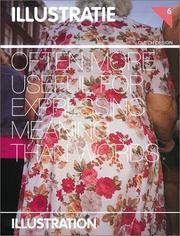| Listing 1 - 10 of 21 | << page >> |
Sort by
|
Book
ISBN: 9036801095 9789036801096 Publisher: Hilversum Ben Bos, BNO
Abstract | Keywords | Export | Availability | Bookmark
 Loading...
Loading...Choose an application
- Reference Manager
- EndNote
- RefWorks (Direct export to RefWorks)
Aspecten van het beroep van grafisch ontwerper.
Drukwerk --- grafische vormgeving. --- Marketing --- Bos, Ben --- grafische vormgevers --- huisstijl --- 753 --- Total Design --- Total identity --- grafische vormgeving , geschiedenis, grafische vormgevers afzonderlijk --- Financiewezen --- designers
Book
ISBN: 9064504636 Year: 2004 Publisher: Rotterdam 010
Abstract | Keywords | Export | Availability | Bookmark
 Loading...
Loading...Choose an application
- Reference Manager
- EndNote
- RefWorks (Direct export to RefWorks)
766.071 SANDBERG --- Ad Petersen --- Amsterdam --- Nederland --- Sandberg Willem --- Stedelijk Museum --- affiches --- boeken --- boekomslagen --- boekontwerp --- grafiek --- grafische vormgeving --- grafische- en reclamevormgeving --- twintigste eeuw --- typografie --- 753 --- Sandberg --- grafische vormgeving , geschiedenis, grafische vormgevers afzonderlijk --- typography --- Museology --- graphic design --- Sandberg, Willem --- Publishers. Printers
Book
ISBN: 9789401424363 9401424365 Year: 2015 Publisher: Tielt Lannoo
Abstract | Keywords | Export | Availability | Bookmark
 Loading...
Loading...Choose an application
- Reference Manager
- EndNote
- RefWorks (Direct export to RefWorks)
Dooreman is een begrip in de wereld van vormgeving en typografie, een kwaliteitslabel. Zijn boekcovers voor Tom Lanoye, zijn posters voor het Toneelhuis, Theater Antigone en het NTGent, zijn banier aan de Antwerpse Boerentoren: ze hebben zich ongemerkt in het collectieve geheugen genesteld. Zijn prenten voor Playboy en De Standaard Magazine kunnen moeiteloos tippen aan het beste wat binnen-en buitenlandse vakgenoten bij elkaar hebben getekend. Dit boek is een geactualiseerde, gelimiteerde en gesigneerde editie van de monografie die in 2009 van De Grote Letterzetter uitkwam. Met meer dan 100 pagina's aan extra reproducties van covers, binnenwerk, affiches en tekeningen, en bijdragen van onder meer Tom Lanoye, Michiel Hendryckx, Gerda Dendooven en Wim Opbrouck. Dooreman ontving de Henry van de Velde Award voor Loopbaan 2014. --Lannoo
Toegepaste grafiek. --- Publishers. Printers --- Dooreman, Gert --- Typografen --- Boekomslagen --- Typografie --- Affiches --- 766.07 --- 76.07 --- Grafische vormgevers ; 1982-2014 ; Dooreman --- Trefwoord --- Boekdesign ; typografie --- Redactionele vormgeving --- Illustraties --- Boeken ; vormgeving --- Theateraffiches en -brochures --- Posters --- Belgische kunstenaars --- Lay-out --- Gebruiksgrafiek ; grafische designers, reclamekunstenaars, typografen, illustrators A-Z --- Grafische kunst ; grafische kunstenaars A-Z --- Typograaf --- 790 --- boek geschiedenis --- affiche --- grafische kunst --- kunstenaars --- artistes --- Dooreman --- Dooreman, G.
Book
ISBN: 0946311021 Year: 1990 Publisher: Forest Row Artists Bookworks
Abstract | Keywords | Export | Availability | Bookmark
 Loading...
Loading...Choose an application
- Reference Manager
- EndNote
- RefWorks (Direct export to RefWorks)
Lasar (El) Markowitsch Lissitzky 1890-1941 (°Smolensk, ex-USSR) --- Abstracte kunst ; Abstraction-Création --- Bauhaus --- Grafische kunsten ; boekdesign --- Russisch Constructivisme --- Proun --- Schilderkunst ; Russische avant-garde ; suprematisme --- Grafische vormgevers ; 1910-1940 ; El Lissitzky --- 766.07 --- Gebruiksgrafiek ; grafische designers, reclamekunstenaars, typografen, illustrators A-Z --- Suprematism in art. --- Art --- Political aspects --- Lissitzky, El, --- Aesthetics --- Aesthetics.

ISBN: 9063690037 Publisher: Amsterdam BIS Publishers
Abstract | Keywords | Export | Availability | Bookmark
 Loading...
Loading...Choose an application
- Reference Manager
- EndNote
- RefWorks (Direct export to RefWorks)
Illustratietechnieken --- Grafische vormgevers ; illustraties ; Nederland --- Beroepsorganisatie van Nederlandse Ontwerpers ; BNO --- Nederlands ontwerp ; Dutch design ; jaarboeken --- 766(492) --- Gebruiksgrafiek ; Nederland --- eindredactie Willemijn de Jonge, Susanne Verhoog, Rita van Hattum, Rob Huisman ; inleidende tekst Martin Bril --- grafische vormgeving --- BNO --- jaarboek --- wedstrijden --- Nederland --- illustraties --- 766 --- 2000 --- -684.94 --- fictie --- kinderboeken --- non-fictie --- reclame --- het boek, boekillustratie --- Illustratietechniek
Book
ISBN: 9029062983 9789029062985 Year: 1998 Publisher: Nederland Meulenhoff
Abstract | Keywords | Export | Availability | Bookmark
 Loading...
Loading...Choose an application
- Reference Manager
- EndNote
- RefWorks (Direct export to RefWorks)
Escher, Maurits Cornelis, --- prints [visual works] --- Escher, Maurits Cornelis --- prentkunst --- 76 ESCHER, MAURITS CORNELIS --- 76 ESCHER, MAURITS CORNELIS Grafische kunsten. Grafiek. Prentkunst--ESCHER, MAURITS CORNELIS --- Grafische kunsten. Grafiek. Prentkunst--ESCHER, MAURITS CORNELIS --- Ontwerpers --- Kunstenaars --- Vormgevers --- #gsdbA --- Ontwerper --- Kunstenaar --- Vormgever --- Escher, M. C. --- Escher, Mauricio, --- Escher, Maurits Cornelis. --- Arts graphiques neerlandais --- Escher, M.C.
Book

ISBN: 907671424X Year: 2005 Publisher: Gent : A&S/books,
Abstract | Keywords | Export | Availability | Bookmark
 Loading...
Loading...Choose an application
- Reference Manager
- EndNote
- RefWorks (Direct export to RefWorks)
Dutch literature --- Universiteit Gent. --- Bibliotheek --- Buildings. --- 027.71 <493 GENT> --- 027.71 <493 GENT> Universiteitsbibliotheken--België--GENT --- Universiteitsbibliotheken--België--GENT --- erfgoededucatie --- Boekillustraties ; jeugdboeken ; de Gentse Boekentoren --- Kinderboeken --- Grafische vormgevers ; illustraties --- 766.07 --- Gebruiksgrafiek ; grafische designers, reclamekunstenaars, typografen, illustrators A-Z --- 766.32.07 --- Grafische industrie en ontwerp ; beeld ; illustratie ; illustratoren ; cover designers ; concept artists --- Universiteitsbibliotheek (Gent). --- educatie. --- kinderboek. --- architectuur. --- Gent. --- Universiteitsbibliotheek (Gent) --- educatie --- kinderboek --- architectuur --- Gent --- Ghent University, Booktower.

ISBN: 9780262134729 0262134721 9780262278874 0262278871 1429412925 9781429412926 1282098063 9781282098060 9786612098062 6612098066 Year: 2006 Publisher: Massachusetts The MIT Press
Abstract | Keywords | Export | Availability | Bookmark
 Loading...
Loading...Choose an application
- Reference Manager
- EndNote
- RefWorks (Direct export to RefWorks)
This title presents ten laws of simplicity for business, technology, and design that teach us how to need less but get more. Finally, we are learning that simplicity equals sanity. We're rebelling against technology that's too complicated, against DVD players with too many menus, and software accompanied by 75-megabyte "read me" manuals. The iPod's clean gadgetry has made simplicity hip. But sometimes we find ourselves caught up in the simplicity paradox: we want something that's simple and easy to use - but also does all the complex things we might ever want it to do. In "The Laws of Simplicity", John Maeda offers guidelines, ten laws for balancing simplicity and complexity in business, technology, and design - for needing less and actually getting more. Maeda - a professor in MIT's Media Lab and a world-renowned graphic designer - explores the question of how we can redefine the notion of "improved" so that it doesn't always mean something more, something added on. Maeda's first law of simplicity is "Reduce." It's not necessarily beneficial to add technology features just because we can. And the features that we do have must be organized (Law 2) in a sensible hierarchy so users aren't distracted by features and functions they don't need. But simplicity is not less just for the sake of less. Skip ahead to Law 9: "Failure: Accept the fact that some things can never be made simple." Maeda's concise guide to simplicity in the digital age shows us how this idea can be a cornerstone of organizations and their products - how it can drive both business and technology. We can learn to simplify without sacrificing comfort and meaning, and we can achieve the balance described in Law 10. This law, which Maeda calls "The One," tells us: "Simplicity is about subtracting the obvious, and adding the meaningful."
Systems engineering. --- Systems engineering --- 745.01 --- computers --- design --- eenentwintigste eeuw --- eenvoud --- grafische vormgeving --- nieuwe media --- productdesign --- productontwikkeling --- technologie --- Engineering systems --- System engineering --- Engineering --- Industrial engineering --- System analysis --- Design and construction --- Trendwatching --- 770.6 --- Maeda, John --- minimalisme --- vormgeven --- productdesign, filosofie, esthetiek en kritiek --- 766.07 --- Computerkunst ; technologie in de kunst --- Digitale grafische vormgevers ; 2006 ; John Maeda --- Digitale kunsten ; vrije en toegepaste ; theorie --- Maeda, John °1966 (°Seattle, Verenigde Staten)
Book
ISBN: 9789774168918 9774168917 9781649031952 1649031955 Year: 2020 Publisher: Cairo New York
Abstract | Keywords | Export | Availability | Bookmark
 Loading...
Loading...Choose an application
- Reference Manager
- EndNote
- RefWorks (Direct export to RefWorks)
"Arab graphic design emerged in the early twentieth century out of a need to influence, and give expression to, the far-reaching economic, social, and political changes that were taking place in the Arab world at the time. But graphic design as a formally recognized genre of visual art only came into its own in the region in the twenty-first century and, to date, there has been no published study on the subject to speak of. A History of Arab Graphic Design traces the people and events that were integral to the shaping of a field of graphic design in the Arab world. Examining the work of over eighty key designers from Morocco to Iraq, and covering the period from pre-1900 to the end of the twentieth century, Bahia Shehab and Haytham Nawar chart the development of design in the region, beginning with Islamic art and Arabic calligraphy, and their impact on Arab visual culture, through to the digital revolution and the arrival of the Internet. They look at how cinema, economic prosperity, and political and cultural events gave birth to and shaped the founders of Arab graphic design. Highlighting the work of key designers and stunningly illustrated with 360 colour images, A History of Arab Graphic Design is an invaluable resource tool for graphic designers, one which, it is hoped, will place Arab visual culture and design on the map of a thriving international design discourse"--
Graphic arts --- graphic design --- typography --- graphic arts --- Arabic [style] --- #breakthecanon --- anno 1900-1999 --- Graphic design (Typography) --- Posters --- 766(53) --- Grafische vormgevers ; Arabische staten --- Grafische kunst ; Arabische staten --- Art, Graphic --- Arts, Graphic --- Graphic design (Graphic arts) --- Graphics --- Art --- Visual communication --- Advertising, Pictorial --- Picture posters --- Advertising, Outdoor --- Pictures --- Bill-posting --- Signs and signboards --- Typographic design --- Design --- Printing --- Layout (Printing) --- Gebruiksgrafiek ; Arabische staten en gebieden --- History --- 766(091)(53) --- Grafische industrie en ontwerp (algemeen) ; geschiedenis (overzicht) ; Arabische Staten
Book
ISBN: 9071614026 9789071614026 Year: 1987 Publisher: Zandhoven Groep Interecho
Abstract | Keywords | Export | Availability | Bookmark
 Loading...
Loading...Choose an application
- Reference Manager
- EndNote
- RefWorks (Direct export to RefWorks)
graphic arts --- Graphic arts --- art [fine art] --- posters --- typography --- Iconography --- Graphics industry --- design [discipline] --- Art --- Ibou, Paul --- anno 1900-1999 --- Belgium --- Graphic signs --- Kunst --- Design --- Publicité --- Typographie --- Ibou, Paul, --- 766.07 --- Ibou, Paul °1939 (°Antwerpen, België) --- Belgische kunstenaars --- Structurele ; geometrische ; constructieve kunst ; P. Ibou --- Geometrisch conceptuele kunst ; Paul Ibou --- Grafische vormgevers ; 20ste eeuw ; Paul Ibou --- Art, Graphic --- Arts, Graphic --- Graphic design (Graphic arts) --- Graphics --- Visual communication --- Gebruiksgrafiek ; grafische designers, reclamekunstenaars, typografen, illustrators A-Z --- Kunst- en designliefhebbers --- Grafische tekens --- Grafische industrie --- Grafische kunsten --- logos --- advertising art --- prentkunst --- 766.23.07 --- Grafische industrie en ontwerp ; schrift ; logo & pictogram ; logo-ontwerpers ; pictografische taalsystemen --- art [discipline]
| Listing 1 - 10 of 21 | << page >> |
Sort by
|

 Search
Search Feedback
Feedback About
About Help
Help News
News